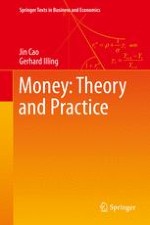2019 | OriginalPaper | Buchkapitel
3. Interaction Between Monetary and Fiscal Policy: Active and Passive Monetary Regimes
verfasst von : Jin Cao, Gerhard Illing
Erschienen in: Money: Theory and Practice
Verlag: Springer International Publishing
Aktivieren Sie unsere intelligente Suche, um passende Fachinhalte oder Patente zu finden.
Wählen Sie Textabschnitte aus um mit Künstlicher Intelligenz passenden Patente zu finden. powered by
Markieren Sie Textabschnitte, um KI-gestützt weitere passende Inhalte zu finden. powered by
